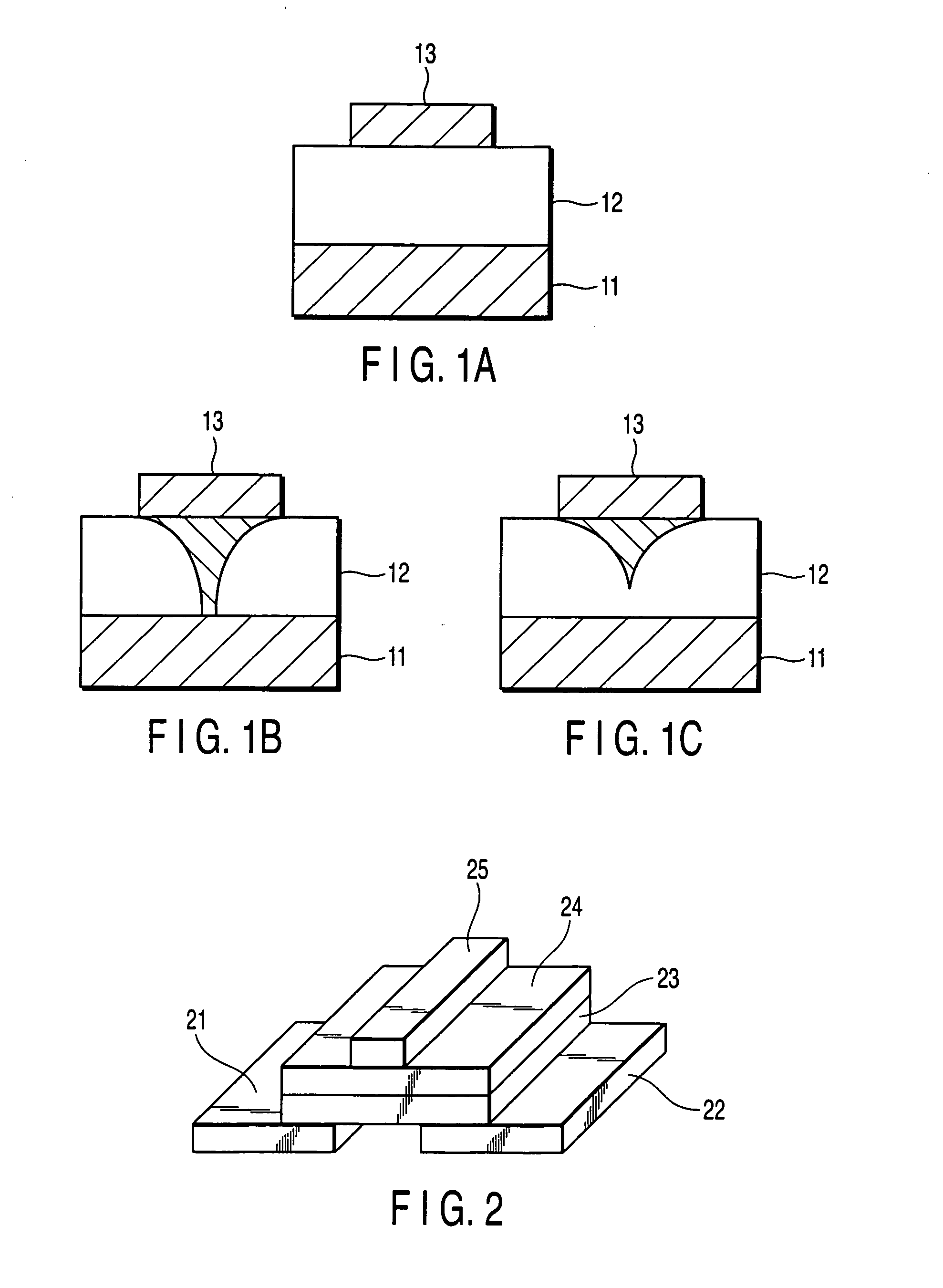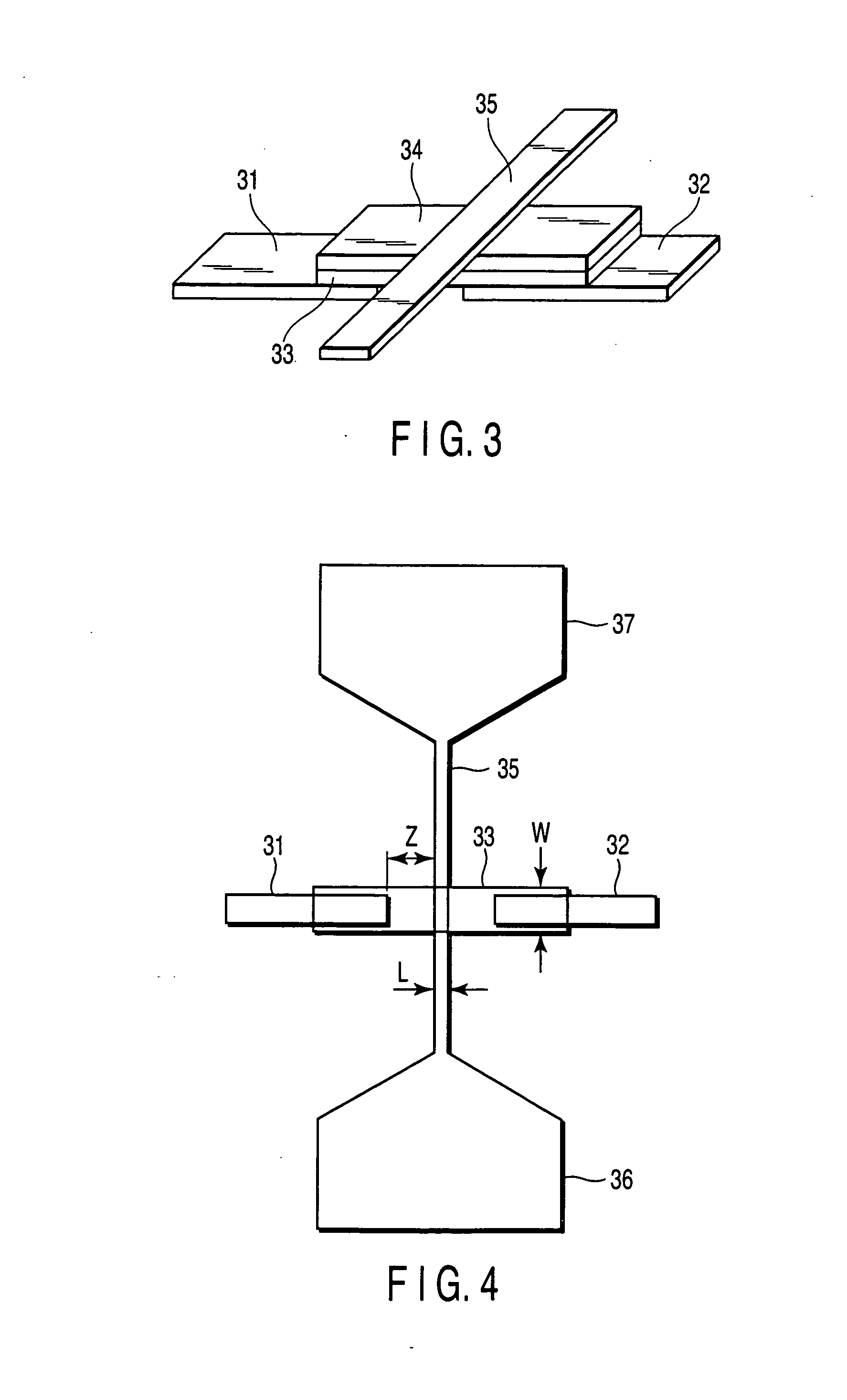Switching element, line-switching device and logic circuit
a technology of logic circuit and switching element, which is applied in the direction of semiconductor devices, digital storage, instruments, etc., can solve the problems of large leakage current of sram incorporated in each crossbar circuit, increasing the power consumption of the entire circuit,
- Summary
- Abstract
- Description
- Claims
- Application Information
AI Technical Summary
Benefits of technology
Problems solved by technology
Method used
Image
Examples
first embodiment
[0065]FIGS. 3 and 4 are schematic views showing the structure of a switching element according to a first embodiment of the invention. FIG. 3 is a perspective view, and FIG. 4 is a plan pattern diagram. In the figures, reference numeral 31 denotes an input electrode, reference numeral 32 denotes an output electrode, and reference numeral 33 denotes a phase change film. Further, reference numeral 34 denotes an insulation film, reference numeral 35 denotes a resistance heating member, and reference numerals 36 and 37 denote conducting electrodes.
[0066] The electrodes 31 and 32 are located on a substrate, not shown, with a certain distance therebetween, and the phase change film 33 bridges the electrodes 31 and 32. More specifically, the phase change film 33 continuously grows from the upper surface of the input electrode 31 to that of the output electrode 32. The phase change film 33 is formed of, for example, GeSeTe, and has its resistance varied in accordance with the state of the ...
second embodiment
[0079]FIG. 6 is a circuit diagram illustrating a line-switching device according to a second embodiment of the invention. This device is part of an FPGA.
[0080] On a substrate, not shown, a plurality of logic circuits 63 are provided, a plurality of lines (first lines) 61 are arranged in the row direction, and a plurality of lines (second lines) 62 are arranged in the column direction. The terminal of each logic circuit 63 is connected to the corresponding one of the lines 61.
[0081] A switching element 64 is provided as a crossbar circuit at each intersection of the lines 61 and 62. One electrode of the switching element 64 is connected to the line 61, and the other electrode is connected to the line 62. The ON / OFF of the switching element 64 is controlled by a control command from a control circuit 65.
[0082] The switching element 64 employed in the second embodiment is similar to that in the first embodiment, and constructed as shown in FIGS. 3 and 4. The conducting electrodes 36...
third embodiment
[0085]FIG. 7 is a plan view schematically illustrating the structure of a switching element according to a third embodiment. In FIG. 7, elements similar to those of FIG. 4 are denoted by corresponding reference numerals, and no detailed description will given thereof.
[0086] The third embodiment differs from the first embodiment in that in the former, a non-linear resistance element 38 is connected in series to the resistance heating member 35. As shown in FIG. 8, in the non-linear resistance element 38, its resistance (and hence the amount of the current flowing therethrough) is varied when the polarity of the voltage is varied, even if the voltage level is not varied.
[0087] When the non-linear resistance element 38 is connected in series to the resistance heating member 35, even if the absolute value of the voltage applied between the conducting electrodes 36 and 37 is unchanged, the amount of the current flowing therethrough can be varied simply by varying the application direct...
PUM
 Login to View More
Login to View More Abstract
Description
Claims
Application Information
 Login to View More
Login to View More - R&D
- Intellectual Property
- Life Sciences
- Materials
- Tech Scout
- Unparalleled Data Quality
- Higher Quality Content
- 60% Fewer Hallucinations
Browse by: Latest US Patents, China's latest patents, Technical Efficacy Thesaurus, Application Domain, Technology Topic, Popular Technical Reports.
© 2025 PatSnap. All rights reserved.Legal|Privacy policy|Modern Slavery Act Transparency Statement|Sitemap|About US| Contact US: help@patsnap.com



